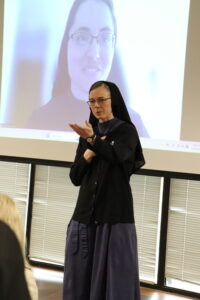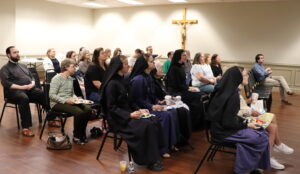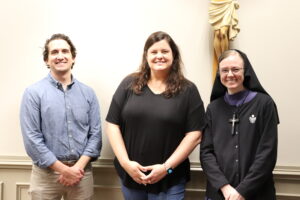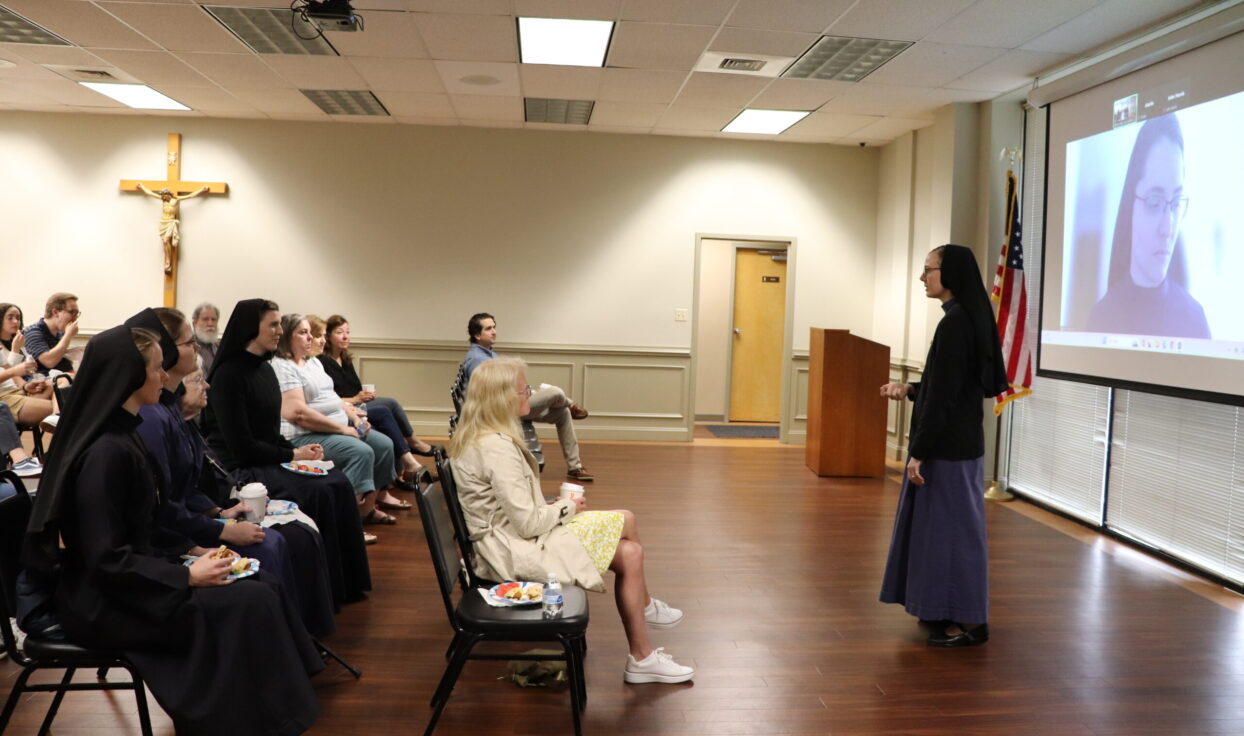St. Gianna Guild sponsors presentation by Religious Sisters of Mercy physician
By Gabrielle Nolan
Concerns about transgenderism and gender ideology are at the forefront of social issues within the United States and around the world.
As secular institutions more commonly perform sex reassignment surgeries and provide puberty blockers to children, how do Catholic medical professionals engage with adults and adolescents who struggle with gender dysphoria? How do those in health care keep their conscience clear while navigating the social pressures of “gender affirming care?”
The St. Gianna Guild of the Catholic Medical Association in Knoxville focused on these issues with a research-based presentation on May 18 titled “Addressing Transgender Issues as a Catholic Health-care Professional.”

Sister Mary Lisa Renfer, RSM, a doctor of osteopathic medicine, introduces Sister Mara, who is shown on the screen in the background. Sister Mara has extensively researched gender dysphoria and transgenderism. (Photo Gabrielle Nolan)
The presentation was led by Sister Mara Lester, MD, a Religious Sister of Mercy of Alma, Mich. Sister Mara, a psychiatrist, attended medical school at George Washington University in Washington, D.C., and was in residency at Washington University in St. Louis. She currently serves at the Sacred Heart Mercy Health Care Clinic in Alma.
“This talk is something I’ve given, with many iterations I can say, over many years since residency and onward to different groups, and I’ve been updating it through time,” Sister Mara explained. “I was first introduced to this topic when I was a med student on an endocrinology rotation for just a week or two, and I had a patient present who asked for testosterone because she wanted to be a male because she was in a relationship with another woman and considered herself heterosexual.”
“When I was in residency, I had encountered some adult transgender patients, as well as some 14-year-old twin girls that wanted to transition when I was on my child/adolescent psychiatric rotations,” she continued. “So, there were just a lot of circumstances that I personally encountered that I just questioned significantly. So, it’s kind of put me on a pursuit to read much about this through time.”
Sister Mara began her presentation with a list of definitions to provide clarity around the subject.
The Merriam-Webster Dictionary defines sex as “either of the two major forms of individuals that occur in many species and that are distinguished respectively as female or male especially on the basis of their reproductive organs and structures.”
Gender is defined as “the behavioral, cultural, or psychological traits typically associated with one sex.”
Sister Mara mentioned there is now common usage of the phrase “gender identity,” where an individual refers to himself or herself as a male, female, or other category.
The Diagnostic and Statistical Manual of Mental Disorders, 5th Edition, defines gender dysphoria as “a general descriptive term that refers to an individual’s affective/cognitive discontent with the assigned gender. There is a marked incongruence between one’s experience/expressed gender and assigned gender, of at least six months duration.”
The text defines transgender as “the broad spectrum of individuals who transiently or persistently identify with a gender different from their natal gender.”
“Often there is distress that accompanies the incongruence that the person experiences,” Sister Mara said.
Published in 2013, The Diagnostic and Statistical Manual of Mental Disorders, 5th Edition, cited that gender dysphoria affects 0.005-0.014 percent of natal adult males and 0.014 percent of natal adult females.
“This has seemingly been increasing through time,” Sister Mara said, noting that a recent estimate stated 0.4 percent of U.S. adults identify as a gender that does not correspond to their biological sex.
“Does childhood gender dysphoria persist?” Sister Mara questioned. “In looking at the research that’s been out there, especially in Canada, 70-95 percent of cases resolve, that the child accepts their gender identity that is congruent with their biological sex.”
However, there has been an increase in referrals to gender clinics.
“In years past, it was often a biological male who presented to become a transgendered female, but since the mid-2000s there’s been a huge uptick in young women, specifically adolescent women, being referred to gender clinics,” Sister Mara stated.
“There’s also a question, is this gender dysphoria kind of a catch-all diagnosis for anything that an adolescent has disturbance with?” she continued. “It’s a disturbing time to go through puberty and all of the social changes and everything. It’s not easy, and so is this something more readily thought of at this point in time?”
While no single cause for gender dysphoria has been found, Sister Mara suggested that gender dysphoria could be more of a symptom.
Several factors in an individual’s life could play a role: biological factors, such as genetics, prenatal sex hormones, or temperament; family dynamics, such as abandonment, attention-seeking, or insecure attachment relationships; adverse childhood experiences or trauma, such as sexual abuse; a primary mental-health diagnosis, such as autism spectrum disorder, ADHD, depression, social anxiety, or borderline personality disorder; bullying from peers for atypical areas of interest; inherent distress; or coping with negative feelings about self or behavior.
“I find in my work there’s just a lot of opportunity to improve coping for young persons and persons in general,” Sister Mara said. “They don’t necessarily have the stability or learn the mechanisms to work with stress, to work with confusion, and this would be advantageous.”

Health-care professionals join Father Adam Royal, who is the St. Gianna Guild chaplain, and Religious Sisters of Mercy of Alma, Mich., for a presentation on transgender and gender dysphoria issues. The presentation was led by psychiatrist Sister Mara Lester, RSM. (Photo Gabrielle Nolan)
Sister Mara referenced significant psychiatric comorbidities for transsexual youth, including increased risk for depression, anxiety disorder, suicide ideation, suicide attempts, and self-harm, and increased inpatient and outpatient treatments.
“Probably the most comprehensive study, back in 2011, by the Karolinska Institute in Sweden actually followed a good number of patients,” Sister Mara said.
“These individuals actually underwent sexual reassignment surgery and then were followed for many years out … like 10 to 20 to 30 years out. And what they found was there was still a 19-fold suicidal mortality risk with this population. Their mental-health concerns actually didn’t change much. They still had depression or low quality of life and increased risk of psychiatric hospitalizations,” she added.
As for contemporary approaches of care toward people with gender dysphoria, Sister Mara said “many have supported more cautious care, that we try to understand and address underlying psychosocial morbidity… trying to investigate underlying factors, and then provide psychological counseling and support.”
She noted that she has “great concern” about society’s approach to gender dysphoria, which includes a “gender affirmation” approach.
“There’s much more of a contemporary ‘gender affirmation’ approach that many try to support and encourage affected patients to adopt a social role in accord with gender identity irrespective of their biological sex, social transitioning with preferred pronouns, cross dressing, etc. The efforts to identify psychological approaches to mitigate dysphoria with or without desistance have largely been abandoned, I think, up unto this point,” Sister Mara said.
She highlighted that medical terms are changing with health-care practices. Gender reassignment surgery can be called gender “affirming” or “recognition” surgery, and natal sex can be reworded to sex “assigned” at birth. Disorders of sexual development are now called “differences” of sexual development. And, perhaps most commonly, forms notating sex as male or female may now contain options such as “gender nonconforming,” “transgender,” or “bisexual,” among others.
For men and women who transition, there are different transitioning phases, which range from reversible to partially reversible to irreversible.
Reversible actions include acquiring preferred gender hairstyles, clothing, and play, and adopting a new name. Partially reversible actions include cross-gender hormone therapy for ages 16 and younger, such as estrogen, spironolactone, and testosterone.
There are many surgical procedures that are irreversible that individuals may choose to undergo for their transition. These might include vaginoplasty, labioplasty, tracheal shave, liposuction, breast implants, jaw shaping, orchiectomy, mastectomy, construction of neoscrotum, metoidioplasty, phalloplasty, hysterectomy, and oophorectomy.
“There’s all these different things that people do, from male to female or female to male,” Sister Mara said. “You’re trying to adjust the physical look of the body so that it looks like the opposite sex, but obviously it does not function in that capacity.”
“Sex hormone therapy is not benign, and honestly, puberty blockade is not benign,” she continued. “We don’t know the long-term effects of this, and this is largely experimental. We don’t know how ultimately it impacts bone development … as well as a lot of brain development. Those hormones do a lot for that.”
Sister Mara noted that there are several risks associated with sex hormone therapy, such as breast cancer, coronary artery disease, thromboembolic disease, cerebrovascular disease, liver dysfunction, hypertension, uterine cancer, and more.
Although the long-term risks of sex hormone therapy have not been fully established, some possibilities can include decreased bone density, cardiovascular risk factors, and sterilization or loss of fertility.
“Persons pursuing this are often given or recommended to give reproductive-sparing modalities. Obviously, we have moral, ethical concerns with that as Catholics,” Sister Mara said.
“But basically, you’re sterilizing these individuals, and do they understand at the time that they’re undergoing this what this means? What this means for their body or for their future? And I think if any of us think back to the time when we were 12 or 14 or 16 or 17, do we really think about what our life trajectory is going to bring forth? How many children we might have? What we think about our sexuality or relationships? So, there’s a lot to be said here about how well-informed or how can the adolescent brain think about this and how is informed consent actually occurring? There’s great concerns,” she noted.
Another side to address, Sister Mara mentioned, are the individuals who detransition.
“I’m so grateful that more of these individuals are coming forth to tell their stories,” she said. “There’s just such agony and difficulty in these persons’ lives. They’re really suffering, truly suffering. And what I found the most horrendous when I was reading on this, persons can tragically commit suicide because of the distress that they’re under.”
There also has been backlash in the trans community when individuals detransition, with death threats and name calling such as “traitor” or “transphobe.”
Sister Mara noted that individuals detransition for a variety of reasons: they become more comfortable with their natal sex; they have medical concerns about transitioning; or they realize their gender dysphoria was caused by another issue, such as abuse or trauma.
At the end of her presentation, Sister Mara recommended for all present to “have compassion for people who are suffering.”
“There’s a lot of suffering here, I think on all sides, especially the children and adolescents who are kind of caught in this for whatever the reason, whether they have gender dysphoria or whether they’re concerned about it or scared or confused, to all the providers who are swept up in this discourse or pressures,” she said. “I think we really need to appropriately address psychiatric comorbidities, and I can speak to my own personal experience of just barely touching on a couple of patients that I just had grave concern about their comorbidities and how they were being handled.”
Sister Mara also recommended building up sexual education and Theology of the Body, especially within the home.
“Not just the physiological understanding of the body, but what does that mean relating to identity, to just comfort with one’s own sexual experiences or drives or just within the relations we’re called into in order and love and beauty and God, or giving up for the sake of the kingdom for those who are called to celibacy,” she said.

Dr. Phil Hanneman, vice president of the St. Gianna Guild, and Dr. Mallory Trevino, guild communications manager, are joined by Sister Mary Lisa Renfer, who is medical director of the St. Mary’s Legacy Clinic. (Photo Gabrielle Nolan)
Lastly, Sister Mara posed the question of “how do we affirm children, adolescents in their personhood, their talents, their giftedness?”
“There’s a great need for strong female and male role models in a child’s and adolescent’s life,” she said.
After the presentation, she encouraged those in attendance to address any questions.
One health-care provider asked the religious Sister how to handle other professionals promoting gender ideology and performing sex-change surgeries.
“It’s happening, but I also question … how are you giving informed consent from just a basic level? From a moral perspective, I disagree with what they’re doing. I think it’s causing more harm than any good. From a Christian-Catholic perspective, it’s an aberration of the human person. We’re just not allowing the human person to flourish,” she said. “I think we need to be strong, and let your yes be yes and your no be no, as Scripture says. And very gently and firmly but confidently to know you’re standing up for truth and not compromise that.”
“I think there’s multiple levels you can engage with providers on either a professional or personal perspective just to promote a questioning of their stances and hopeful engagement with really what is truth or what is the evidence or lack thereof that is out there,” Sister Mara continued.
Another question related to how to address using an individual’s preferred pronouns when they do not correspond with the individual’s natal sex.
“I think as a Christian, you’re there to be a kind, loving presence of truth and care and concern and openness without compromising the understanding of male and female,” she said. “I personally think the pronouns argument just gets kind of into the weeds and really messy often, so if one can ask what a person’s name is, or what they would like to be called, I think addressing the person by their name and being very direct and kind and looking them in the eye and being as kind as you would to any other patient means something.”
“You’re connecting with them and their humanity in that moment and supporting them and asking if they have any concerns. Or whether you say, ‘I’ll pray for you’ at the end or, ‘I hope you have a good day,’ I just think those little things speak a lot often to individuals. I would try, personally, to avoid the pronoun thing, because if they’re pushing it so much there’s a reason there, but if they could highlight a name or a nickname, at least that’s something you can connect with their humanity,” Sister Mara said.
For further reading, Sister Mara recommended the book The Detransition Diaries, published by Ignatius Press in January. Both a personal and historical account, the book shares stories of seven individuals who sought out “gender affirmative care.”
“I thought it was a great read from a sense of understanding the historical development, bringing up the ethical considerations, just being aware of some detransition stories, and also the ongoing questions about why is there such a rise in the young female population,” Sister Mara said.
Another recommended read was Dignitas Infinita, a declaration from the Vatican’s Dicastery for the Doctrine of the Faith, which was released in early April.
The declaration on human dignity addresses gender theory in paragraphs 55-59 and sex change in paragraph 60.
Paragraph 57 of the document states “regarding gender theory, whose scientific coherence is the subject of considerable debate among experts, the Church recalls that human life in all its dimensions, both physical and spiritual, is a gift from God. This gift is to be accepted with gratitude and placed at the service of the good. Desiring a personal self-determination, as gender theory prescribes, apart from this fundamental truth that human life is a gift, amounts to a concession to the age-old temptation to make oneself God, entering into competition with the true God of love revealed to us in the Gospel.”
The text continues in paragraph 58 to say that “another prominent aspect of gender theory is that it intends to deny the greatest possible difference that exists between living beings: sexual difference. This foundational difference is not only the greatest imaginable difference but is also the most beautiful and most powerful of them. In the male-female couple, this difference achieves the most marvelous of reciprocities. It thus becomes the source of that miracle that never ceases to surprise us: the arrival of new human beings in the world.”



Comments 1
Thank you for this insightful and loving presentation of a problem that has grown out of proportion due to many factors within our society. My heart breaks for the young people who are drawn into this debate and given very little options besides transitioning. I hope the trend to allow psychotherapy to be used to assist these little ones (in spirit) will continue to grow.
God bless all of you.